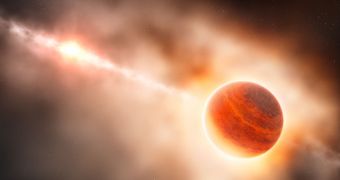Thanks to Kepler, new exoplanets are being discovered all the time. But Kepler is not the only game in town, teams using various other telescopes are making significant discoveries as well.
The European Southern Observatory is boasting about what may be the first ever direct observation of a planet during its early, forming stages.
A team of astronomers have used ESO's Very Large Telescope to study HD 10056, a young star relatively close by, 335 light-years away.
The star is relatively well studied, astronomers already believe a gas giant is orbiting it at roughly six times the distance from the Earth to the sun, or 6 AU.
Now, another gas giant was discovered further out, at 70 AU, surrounded by the gas and dust that typically surrounds new stars.
That's significantly further out than astronomers expect planets, especially gas giants, to form. For comparison, Pluto is about 40 AU away from the sun.
"So far, planet formation has mostly been a topic tackled by computer simulations," Sascha Quanz, who led the team that made the discovery, said.
"If our discovery is indeed a forming planet, then for the first time scientists will be able to study the planet formation process and the interaction of a forming planet and its natal environment empirically at a very early stage," he added.
Granted, the discovery is preliminary, astronomers still have to confirm that the planet is there. If it is, the next question is whether it formed so far away or was pushed out from a shorter initial orbit.
The team used the VLT to find the planet. They used a coronagraph, which blocks the bright light from the star and makes it possible to observe the area right next to it. Astronomers spotted a faint blog within the gas and dust disk around the star.

 14 DAY TRIAL //
14 DAY TRIAL //